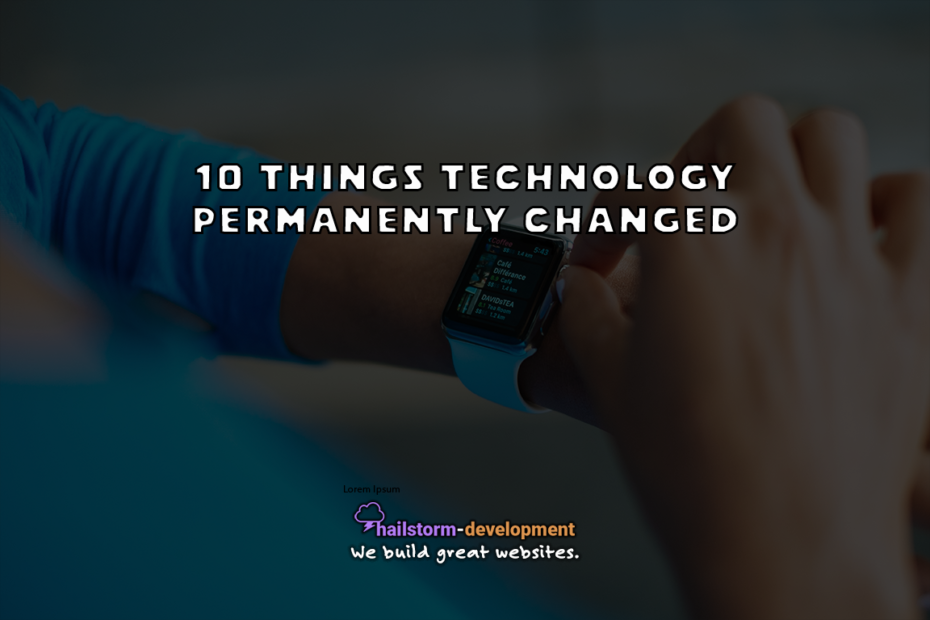10 Things Technology Changed
Have you ever thought about 10 things technology has changed? Obviously, there’s more than just ten, but we thought it might be a good starting point. Continue reading to learn some of the effects technology has had on our world in the past two decades.
Y2K: The Start of a New Era
Even before the start of the new millenium, digital technology began to steamroll its analog predecessors. For example, the VHS tape was replaced by the DVD in 1995. Another example was the Apple iPhone – one of the first smartphones on the market. The technology market has been evolving rapidly in the last twenty years.
10. WiFi - Essential for Working From Home
Despite my age, I can recall when Wi-Fi wasn’t available at restaurants and mobile phones only existed for calling and texting. Nowadays, Wi-Fi can be found almost anywhere public, as well as private residences. You might notice that some businesses offer free Wi-Fi if you create an account with them.
9. Internet of Things
The Internet of Things (IoT) allows people, animals, and objects to transmit information automatically without interacting with a computer or another person. For example, tire pressure monitoring sensors (TPMS) are in the IoT. It doesn’t stop there, though. Tens of billions of internet-connected devices turn on our lights, tell us who’s at the front door, and alert us when we need more milk.
8. Voice Assistants
If you missed our blog about the top 3 voice assistants in 2020, check it out. We break down the differences between Amazon Alexa, Google Assistant, and Siri. Additionally, we review the benefits, pros, and cons of using them. In 2019, there were more than 3.25 billion voice assistant devices in use.
7. Bluetooth
Bluetooth, when it was first introduced, connected a mobile phone to a hands-free headset. Since 1999, Bluetooth has expanded to include earbuds, earphones, wireless speakers, and more. Further, fitness trackers use Bluetooth to stream data to mobile phones.
6. VPN
Virtual private networks (VPN) refer to an encrypted tunnel that’s created to transfer data on the internet. Using a VPN can be beneficial if you want to reduce long-distance phone charges, access regional sports coverage, or access region-blocked services. Lastly, use a VPN to protect your private information, prevent data-throttling, and bandwidth-throttling.
5. Drones
Drones have taken off (pun intended) in recent years. When they were first introduced, they were mostly only used by hobbyists. However, drones have been used for shooting movie sequences, delivering packages, spraying pesticide on crops, and more. Soon, drones are expected to be used as air taxis for delivering medicine, fighting fires, and more.
4. 3D Printing
Next, the use of 3D printing has proven useful for manufacturing running shoes, materials inside football helmets, and more. Also, just a few days ago, the world’s first 3D-printed school was announced. This technology allows manufacturers to build plastic components that are lighter than metal alternatives.
3. Video Conferencing
Thanks to the coronavirus pandemic, video conferencing blew up as employees scrambled to stay in touch with each other without being able to meet face-to-face. Thus, with companies and schools adopting work and study from home, video conferencing software became a must. Correspondingly, Zoom, Slack, and even iChat received hundreds of thousands of downloads last summer as more friends and families adopted this form of communication.
2. Music Streaming
Similarly to video, music has evolved from its analog forms – vinyl records, CDs, cassettes – to digital, downloadable files. However, unlike when the iPod hit the market, downloading all of the songs isn’t required. Spotify, Apple Music, and Amazon have music streaming services for a monthly fee.
1. Virtual Reality
To say nothing of virtual reality than what we covered in the top tech trends of 2021 would be a mistake. So, in short, virtual reality involves a unique, life-sized digital world. While the video game industry saw a boost from virtual reality, the general tech industry did as well. VR has been applied in education, healthcare, architecture, and nascent technology.
In Conclusion
Lastly, with these 10 things technology changed, we can continue to expect them to improve as time progresses. For the most part, though the technology of things like Bluetooth will remain consistent, large variations can exist in each category, like drones, for example. In any case, like with the tech trends of the year, we will have to wait and see how things pan out.
Did we leave tech out you think was monumental to our world? Let us know in the comments below.
Resources & Further Reading
- Musil, S. (2020, May 30). 25 technologies that have changed the world. Retrieved February 22, 2021, from https://www.cnet.com/news/25-technologies-that-have-changed-the-world/
Hillyer, M. (2020, November 18). Here’s how technology has changed the world since 2000. Retrieved February 22, 2021, from https://www.weforum.org/agenda/2020/11/heres-how-technology-has-changed-and-changed-us-over-the-past-20-years/
Technology in Our Life Today and How it Has Changed: Updated for 2020. (2019, November 12). Retrieved February 22, 2021, from https://aginginplace.org/technology-in-our-life-today-and-how-it-has-changed/
